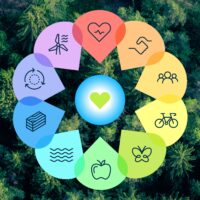SBTi buildings guidance 2024: how to meet the criteria
The buildings sector is a big deal – it’s responsible directly and indirectly for 34% of global energy consumption and 26% of global energy-related emissions. However, a 2023 survey of property developers and investors found that less than one-fifth had set a net zero target.
The Science Based Targets initiative (SBTi) sets the global standard for carbon reduction targets that keep the planet within 1.5°C of warming – the limit set by the Paris Agreement to avoid the most catastrophic impacts of climate breakdown. Thousands of companies are using the SBTi’s near-term and net-zero standards, either committing to halve emissions within ten years, or to reach net-zero emissions by 2050.
Now the SBTi has turned its attention to the built environment to increase ambition and accountability in the sector when it comes to carbon reduction and reporting.

On 28 August 2024, the SBTi released sector-specific criteria for the buildings sector, in recognition of the significant contribution of buildings towards global emissions, and the maturity of the sector in its approach to decarbonisation through retrofit technologies.
The new criteria aim to improve accountability in the sector to ensure that companies buying, selling, developing and managing buildings account for operational and embodied greenhouse gas (GHG) emissions. The SBTi calls this the ‘whole building approach’.
The SBTi also aims to drive ambition in the sector, particularly around embodied emissions – through developing the first-ever decarbonisation pathway for this type of emissions.

The SBTi has developed the Buildings Criteria for the following users:
- Developers
- Owner-occupiers
- Owner-lessors
- Property managers (including those managing buildings on behalf of clients)
- Financial institutions
The criteria apply to companies in the above categories with at least 20% of total greenhouse gas emissions coming from owned or managed buildings. Tenants, and companies operating in construction, architecture and engineering are not in scope of the new SBTi Buildings Criteria. For small and medium-sized enterprises (SMEs) meeting the above criteria it is optional to follow the Buildings Criteria, and they may instead use the target validation route for SMEs.
- Companies meeting these criteria and submitting to SBTi for the first time must follow the criteria from 28 February 2025, six months following its publication. Companies working on their SBTi submissions currently should not have to follow the criteria if they submit before this date.
All companies must review and re-validate their targets with the SBTi every five years.

Users of the criteria can set two types of targets:
- in-use operational emissions target
- up-front embodied emissions target
In-use operational emissions targets must be set when emissions from energy used whilst operating owned or managed buildings are at least 20% of total baseline scope 1, scope 2 and scope 3 (category 1-14) emissions.
Embodied emissions targets apply where up-front embodied emissions of new developments or new build acquisitions exceed 20% of total scope 1, scope 2 and scope 3 (category 1-14) emissions in any one year, over the previous three years. Embodied emissions are those associated with the materials and construction processes that go into a new building.
Targets must be specific to building typology and geographic location. For companies with assets across multiple typologies and locations, multiple targets will be aggregated to produce an overall reduction target through the SBTi Buildings Target-Setting tool.
In line with SBTi’s cross-sector corporate pathway, the target date for a near-term target must be 5-10 years from the target submission, and by 2050 at the latest for a net zero target. Setting a net zero target is optional.
Companies using the criteria will still need to use the SBTi’s cross-sector corporate net-zero standard to set targets for non-building related activities – for example, scope 1 emissions from company cars, or scope 3 emissions from business travel.

- Operational emissions targets
Operational emissions targets must be set as intensity targets, in terms of tonnes of CO2 equivalent per floor area. This is to align with SBTi’s Sectoral Decarbonization Approach (SDA) methodology, which means companies converge to an average intensity for the sector along a 1.5°C decarbonisation pathway. There is not a set reduction amount for these targets - users input their emissions, total floor area and target year into an Excel tool provided by SBTi which generates a reduction rate.
Example target:
Smith & Co commits to reduce scopes 1, 2 and 3 in-use operational GHG emissions of owned and leased buildings 60% per m2 by 2030 from a 2021 base year.
- Embodied emissions targets
Embodied emissions targets can be set as either intensity targets or absolute reduction targets and can use the SBTi’s buildings sector pathway or corporate standard. There is not a set reduction amount - users input their emissions, total floor area and target year into an Excel tool provided by SBTi which generates a reduction rate.
Example target:
Smith & Co commits to reduce upfront embodied scope 3 GHG emissions of new buildings 50% [per m2] by 2030 from a 2021 base year.
A key aspect of SBTi’s criteria is the “whole building approach”, which means including a building’s complete operational energy consumption within a user’s target boundary, regardless of your degree of control over the building as lessor or operator.
Example: You are a landowner who leases a commercial property under a 100-year lease. The tenant has control to make adaptations to the building and they control their energy contract. Under the SBTi Buildings Criteria, the landowner must include the tenant’s operational emissions as part of their inventory of greenhouse gas emissions and reduction targets.
The Buildings Criteria also states that it is mandatory for companies to include fugitive emissions from all building types as part of their GHG inventory and target boundaries. Fugitive emissions mainly arise from refrigeration and air conditioning systems.

The Buildings Criteria recommends that companies use a location-based approach when setting their in-use operational emissions target, but it is not mandatory to do so. Location-based accounting prevents companies from making net-zero claims reliant on market instruments for purchased electricity and shifts the onus onto owners and developers to optimise a building's performance.
If a company chooses to use the market-based approach for target setting, it must also measure and report operational emissions using the location-based approach as part of its GHG inventory.

Users of the buildings sector criteria must make an additional mandatory commitment to install no new fossil fuel equipment in their owned or financially controlled buildings. This must be fulfilled from 2030 at the latest.
For building owners and operators, this would mean not replacing like-for-like any gas heating systems or cooking systems in existing buildings and only installing low-carbon technologies such as heat pumps in new properties. Emergency and back-up systems are exempt from this commitment.

Developers of buildings must follow additional requirements in the Buildings Guidance to ensure they are accountable for the emissions produced by the assets they construct and sell.
Firstly, developers must include upfront embodied emissions of new buildings within their GHG inventory and target boundary. Companies that acquire new constructions as the intended first user must also include these upfront emissions in their targets.
Secondly, developers must set targets to cover the estimated lifetime operational emissions for all buildings sold in the reporting year, assuming a minimum building lifetime of 60 years. These emissions sit within scope 3 category 11 - use of sold products.

Follow these steps to get your company ready to submit your buildings sector criteria to SBTi:
- Measure your baseline carbon footprint
- Include embodied emissions from any new developments
Include fugitive emissions for all owned, operated and leased buildings - Choose a target year – five to ten years away for a near-term target and by 2050 latest for a net-zero target
- Include embodied emissions from any new developments
- Establish the floor area for your total building portfolio in your baseline year
- Estimate the floor area for your total building portfolio in your target year
- Use the SBTi’s Target-Setting Tool to develop your targets
The Buildings Sector Science-Based Targets Explanatory Document is a detailed document with further information on target setting, including definitions, context and specific guidance for different user types, including financial institutions.
We recommend you read and carefully follow the Buildings Sector Science-Based Target-Setting Criteria and SBTi Criteria Assessment Indicators: Buildings Sector to ensure the best chance of validation with the SBTi. Ensure you dedicate adequate time and resources to prepare and check your submission.

You knew this part was coming, right? The bit where we tell you how great our team is - and you drop us a message to find out how we can help.
So, if you weren't aware, we are hugely experienced in turning sustainability goals into science-based targets for organisations of all sizes and sectors. We offer innovative solutions in the built environment and have worked with many large developers and asset owners on their carbon accounting, net-zero strategies and implementation.
From calculating a full carbon footprint using the GHG Protocol, to creating a net-zero roadmap and completing your SBTi application, we can help you make net-zero relevant and achievable for your company.
OK - sales pitch over. We'd love you to get in touch below or book an intro call, and if you're not ready to chat right now, we wish you the best of luck on your net-zero journey! 🏘️🌍⚡









